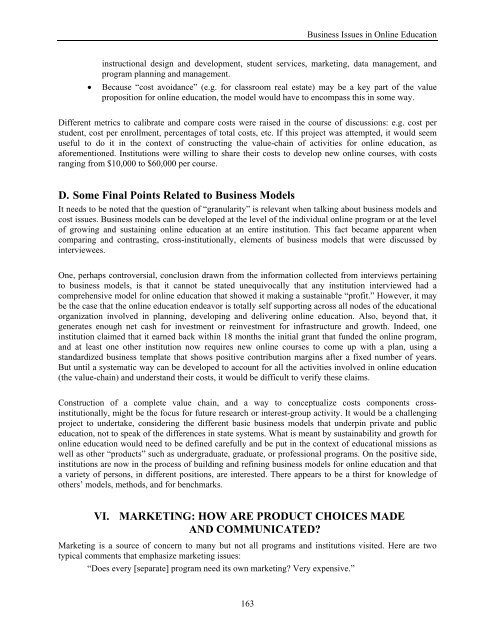Elements of Quality Online Education cation
Elements of Quality Online Education cation
Elements of Quality Online Education cation
You also want an ePaper? Increase the reach of your titles
YUMPU automatically turns print PDFs into web optimized ePapers that Google loves.
Business Issues in <strong>Online</strong> <strong>Edu<strong>cation</strong></strong>instructional design and development, student services, marketing, data management, andprogram planning and management.• Because “cost avoidance” (e.g. for classroom real estate) may be a key part <strong>of</strong> the valueproposition for online edu<strong>cation</strong>, the model would have to encompass this in some way.Different metrics to calibrate and compare costs were raised in the course <strong>of</strong> discussions: e.g. cost perstudent, cost per enrollment, percentages <strong>of</strong> total costs, etc. If this project was attempted, it would seemuseful to do it in the context <strong>of</strong> constructing the value-chain <strong>of</strong> activities for online edu<strong>cation</strong>, asaforementioned. Institutions were willing to share their costs to develop new online courses, with costsranging from $10,000 to $60,000 per course.D. Some Final Points Related to Business ModelsIt needs to be noted that the question <strong>of</strong> “granularity” is relevant when talking about business models andcost issues. Business models can be developed at the level <strong>of</strong> the individual online program or at the level<strong>of</strong> growing and sustaining online edu<strong>cation</strong> at an entire institution. This fact became apparent whencomparing and contrasting, cross-institutionally, elements <strong>of</strong> business models that were discussed byinterviewees.One, perhaps controversial, conclusion drawn from the information collected from interviews pertainingto business models, is that it cannot be stated unequivocally that any institution interviewed had acomprehensive model for online edu<strong>cation</strong> that showed it making a sustainable “pr<strong>of</strong>it.” However, it maybe the case that the online edu<strong>cation</strong> endeavor is totally self supporting across all nodes <strong>of</strong> the edu<strong>cation</strong>alorganization involved in planning, developing and delivering online edu<strong>cation</strong>. Also, beyond that, itgenerates enough net cash for investment or reinvestment for infrastructure and growth. Indeed, oneinstitution claimed that it earned back within 18 months the initial grant that funded the online program,and at least one other institution now requires new online courses to come up with a plan, using astandardized business template that shows positive contribution margins after a fixed number <strong>of</strong> years.But until a systematic way can be developed to account for all the activities involved in online edu<strong>cation</strong>(the value-chain) and understand their costs, it would be difficult to verify these claims.Construction <strong>of</strong> a complete value chain, and a way to conceptualize costs components crossinstitutionally,might be the focus for future research or interest-group activity. It would be a challengingproject to undertake, considering the different basic business models that underpin private and publicedu<strong>cation</strong>, not to speak <strong>of</strong> the differences in state systems. What is meant by sustainability and growth foronline edu<strong>cation</strong> would need to be defined carefully and be put in the context <strong>of</strong> edu<strong>cation</strong>al missions aswell as other “products” such as undergraduate, graduate, or pr<strong>of</strong>essional programs. On the positive side,institutions are now in the process <strong>of</strong> building and refining business models for online edu<strong>cation</strong> and thata variety <strong>of</strong> persons, in different positions, are interested. There appears to be a thirst for knowledge <strong>of</strong>others’ models, methods, and for benchmarks.VI. MARKETING: HOW ARE PRODUCT CHOICES MADEAND COMMUNICATED?Marketing is a source <strong>of</strong> concern to many but not all programs and institutions visited. Here are twotypical comments that emphasize marketing issues:“Does every [separate] program need its own marketing? Very expensive.”163
















